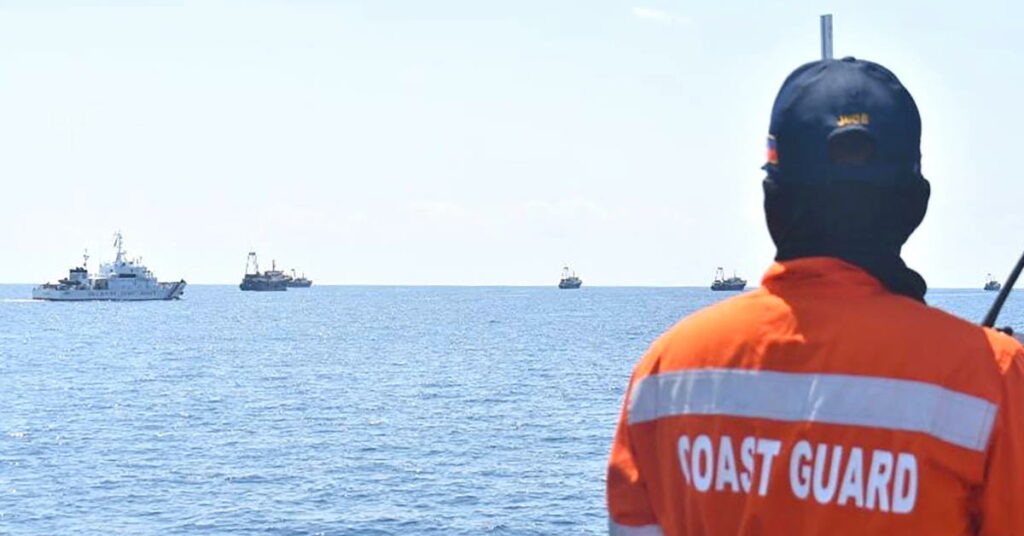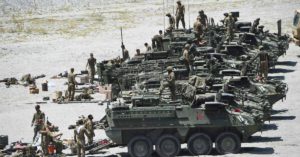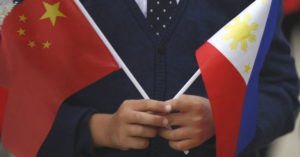
After the exchange of words between Manila and Beijing on the unfortunate incident in the South China Sea (SCS) involving the Philippines and China on 16 November 2021 where three Chinese Coast Guard (CCG) vessels had fired water cannons on two Philippine supply boats have subsided, the area of Ayungin Shoal (Second Thomas Shoal or Rén’ài Jiāo) is now quiet, and the supply run is back to normal.
Thanks to the quiet diplomacy and negotiations through bilateral diplomatic channels, the incident in the Ayungin Shoal was handled well, and did not escalate into a conflagration. No doubt, diplomacy has once again prevailed.
Questions
Nonetheless, even though there’s already a sense of normalcy in the Ayungin Shoal, some questions were left unanswered. For instance, why was the resupply mission being undertaken in the stealth of the night? The most intriguing question is why were the Philippine vessels unusually covered with tarpaulins that the CCG suspected were carrying materials to repair the vessel or construction materials to build some kind of facility on the shoal?
According to Herman Laurel, a prominent columnist-writer in the Philippines, in his latest article titled, “Supply Boats Baiting Water Cannons Won’t Stop China-Backed ASEAN Post-Pandemic Recovery”, “It seemed that the Chinese Coast Guard (CCG) were baited to use the water cannons due to suspicious behaviour of the two Philippine supply boat that had behaved suspiciously and furtively. The information reaching us is the two supply ships were “covered”, which is draped by canvass or tarpaulin so that they and their cargo could not easily be identified by observers. To coastguard officers of any country, this is a flash of red light that elicits a demand to be identified and be inspected. Apparently, as the Department of Foreign Affairs (DFA) tweet seems to indicate, the two supply boats left post haste without further clarification. This other side of the story has not been told both, by the Philippine and international mainstream media,” Laurel wrote in his article.
Laurel further stated in his article that the facts can now only be established by a real investigation, similar to the 2019 GemVer boat accident where an investigation by both sides led to the official declaration of an accident and indemnification. However, there seems to be no interest as Defense Secretary Lorenzana has already said the supply run is back to normal.
He also contended that for many years since Philippine-China relations had improved under President Duterte, no such incident has occurred. Will it be a rational act on the part of China to spoil its flourishing bilateral relations with the Philippines?
Realities On The Ground
Moreover, what happened last 16 November is just an affirmation of the ground realities that the SCS dispute involving multiple countries like China, Vietnam, Malaysia, Brunei, the Philippines, and Taiwan, with multiple overlapping claims, bilateral and trilateral disputes is, in fact, a delicate and complex affair.
However, the incident in the SCS on 16 November involving the Philippines and China is not something new nor an epitome of the gas-lighted “China threat theory” of some politicians from the opposition and “Amboys” (short for American boys in the country).
These kinds of skirmishes happen precisely because the area has been a disputed one for the longest time. That’s the glaring reality. What’s important is at the end of the day, through diplomacy and unobtrusive and quiet negotiations, incidents in the SCS involving the Philippines and China can be dealt with peacefully.
Managing Disputes
Nevertheless, according to Dr Rommel Banlaoi, President of the Philippine Association for Chinese Studies (PACS) in an online webinar organised by the Integrated Development Studies Institute (IDSI), a Manila-based think-tank together with two other think-tanks, Philippines-BRICS Strategic Studies and the Philippine Institute for Peace, Violence, and Terrorism Research (CSPCR) and the Katipunan ng Demokratikong Pilipino (KDP), a political party, on 25 November with the theme “Are We Seeing Tides Shifting on Ayungin Incident, US-PH Military Deal and ASEAN-China Summit? Where is Duterte’s Foreign Policy Going?, “with this recent incident, the Philippines and China must go back to the negotiating table to overcome their misunderstanding on the South China Sea.”
Banlaoi pointed out that both parties need to be reminded of their gains in the Bilateral Consultative Mechanism (BCM) in the South China Sea where they committed to promote pragmatic cooperation to sustain a friendship, pursue common prosperity and achieve peace in the SCS.
Instead of conducting their unilateral actions to assert their respective positions, both countries agreed to work together to encourage coordinated actions and joint management and development of natural resources in the SCS.
Banlaoi purported that there is a need for the Philippines and China to establish another mechanism that can promote closer coordination on the ground to avoid incidents that have the potential of damaging their overall bilateral relations.
Geopolitical expert, Professor Butch Valdes who was one of the panellists advised that the Philippines must not react to these skirmishes or incidents in the SCS on the viewpoint that these are an affront against the Philippines’ sovereignty, but rather look at the bigger picture geopolitically speaking and be more positive in terms of response to the situation.
He said it does not take a genius to see that preparations for war are ongoing between China and the United States (US). He added that the Philippines should think more of its role in promoting peace in the region rather than be pushed to choose a side between the two superpowers.
George Siy, an economic analyst, a Wharton-educated industrialist, director of IDSI, and one of the panellists concurred with Valdes.
“Let us not be the frontline for the military confrontation of the power struggle on who should be number one. China and the US are engaged in this competition and we should not become the frontline of this battle,” Siy expressed.
Siy also acknowledged that the resumption of normalcy in the Ayungin Shoal is a triumph for diplomacy.
Clarifications
On another note, it is important to set the record straight again that the 2016 Arbitral Tribunal ruling did not denote the victory of sovereignty over the territorial and maritime claims of the Philippines in the disputed waters of the SCS. Similarly, the tribunal did not delimit (demarcate or set limits) any maritime boundaries between the Philippines and China in the SCS.
According to Prof. Carlyle Thayer, renowned political scientist, and expert on the SCS, UNCLOS (United Nations Convention on the Law of the Sea) does not apply to sovereignty disputes or disputes over how to delimit maritime zones. The resolution of these disputes is left to the parties concerned to resolve among themselves.
The Arbitral Award simply clarified the maritime entitlements of the Philippines in the West Philippine Sea (WPS), declared the nine-dash line of China as being without basis, acknowledged the damage to the marine ecosystem and resources caused by reclamations in the SCS.
Although the Ayungin Shoal sits within 200 nautical miles of the Philippine coast (105 nautical miles west of Palawan) and based on UNCLOS is part of the Exclusive Economic Zone (EEZ) and continental shelf of the Philippines, which means the Philippines has sovereign rights, according to Prof. Thayer, the Arbitral Tribunal declined to consider Ayungin Shoal or the Second Thomas Shoal because it was a military matter and thus beyond the purview or scope of UNCLOS.
He also clarified in one of his articles that the Permanent Court of Arbitration (PCA) did not hear the case bought by the Philippines against China. The PCA acted as a registry. The case was decided by an Arbitral Tribunal set up under Annex VII (7) of UNCLOS of which China did not participate in and did not recognise the ruling of the arbitral tribunal. Also, unlike the International Criminal Court (ICJ), the PCA is not a United Nations (UN) organisation.
Perspective
To put things in perspective, the most important consideration in situations such as the recent incident in the SCS between claimant-states like the Philippines and China is the fact that no serious military confrontations tantamount to war happened.
Hence, politicising and blowing the recent incident in the SCS out of proportion is not at all helpful or a wise thing to do.
China and the Philippines should pursue more efforts to work together in building an effective mechanism based on mutual trust, and open-minded communication through bilateral diplomatic channels to solve problems amicably and prevent misunderstandings.
Moreover, the Philippines must make a conscious effort to decide which is more important, to have mutually beneficial pragmatic cooperation with China and other claimant states in the SCS, or to be used by an external power to confront China on the issue of sovereignty?
Conclusion
No doubt, to fight for what belongs to the Philippines is an act of patriotism and nationalism. Nonetheless, in doing so, it should be based on facts and realities on the ground because doing otherwise is akin to fooling oneself.
In pursuing claims over the SCS, Filipinos should also think of how best to do it without endangering the country survival and placing it in a precarious situation that could cost lives.
The Philippines as a country should resolve its conflict of interests and differences in the SCS not just with China but with the rest of the claimant states through diplomacy and peaceful means. Diplomacy is also an exercise of sovereignty and a potent weapon in constructively engaging China and other claimant states.
Source: The ASEAN Post
https://theaseanpost.com/article/philippines-managing-disputes-scs



